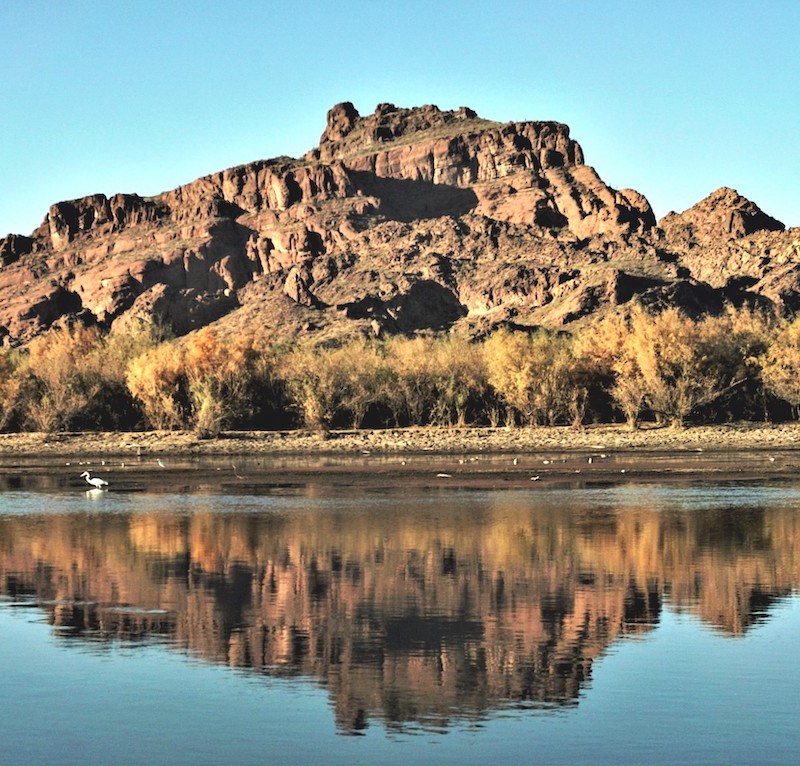
Carol Colborn
In 2017, after RVing across North America for eight years, we settled at the Viewpoint Golf Resort in Mesa, Arizona. A couple of years later, I began seeing amazing photos of horses being regularly posted by neighbors on our Viewpoint Facebook Group. But I always forgot to ask where I could find them. Last December, when I finished publishing my second travel book, I finally did.
Videos by TravelAwaits
Imagine my surprise when I discovered that the Salt River Valley where they roam was only 20 minutes away from our home. After Googling the viewpoints where we could go, my husband and I began to explore the area. We have since visited six of those viewpoints. Here, I give you a summary of everything we have found out about the wild horses and how to enjoy spotting them.

Carol Colborn
The Wild Horses And Their History
There are about 88,000 wild horses in the U.S. The Bureau of Land Management Wild Horses and Burros Program takes care of them, together with the US Forest Service, across 26.9 million acres of public lands in the 10 states of California, Oregon, Utah, Nevada, Wyoming, Colorado, Montana, South Dakota, Texas, and Arizona. More than half are in Nevada. Sadly, Arizona has only about 500 left.
These wild horses in Arizona are “a historic population of unbranded, unclaimed, wild and free-roaming horses.” Sadly, all of the wild horses have a very grim fate. In the 1800s, the herds had grown to millions, roaming the western planes. But, similar to the story of the bison, around 1850, they came to be considered competition for cattle. In fact, they still are.
On July 31, 2015, the US Forest Service announced its plans for their “removal and disposal.” There was an unprecedented public outrage led by the Salt River Wild Horse Management Group. The people moved to stop the annihilation of this cherished herd. They succeeded.
According to historical records, the wild horses had been living in the Salt River Valley since well before the designation of the Tonto National Forest in 1902. An article, dated January 25, 1890, called them “native stock and animals.” To be classified as such, there had to have been five to six generations who knew about their existence. It is estimated that they had been here since before 1790.
Also called mustangs, from the Spanish word mustengo, which means “ownerless beast,” they are believed to be descendants of Spanish horses brought by Spanish explorers in the 16th century. They must have escaped and lived without the caring of man through survival of the fittest. Thus, standing about 13 to 15 hands high, they have evolved to be an incredibly durable and tough breed.

Carol Colborn
Wild Horse Viewpoints In The Salt River Valley
The extensive Salt River Valley lies in central Arizona and contains the Phoenix Metropolitan Area, which encompasses about 20 cities and towns including Phoenix, Scottsdale, Tempe, Gilbert, Chandler, and Mesa, where we live. The Salt River is the largest tributary of the Gila River, extending about 200 miles. Its drainage basin is about 13,700 square miles and it is where the wild horses thrive.
There are about seven viewpoints from which to see the wild horses. But, for the past two years, the best place to see them has been the Coon Bluff Recreation Area. Due to lack of rainfall, the green grass has disappeared in its surroundings. So, around 5 p.m. every day, a couple of trucks bring some hay to feed the horses. It is quite a sight for anyone to see.
About a hundred of them congregate there, from as early as before 4 p.m. They engage in a lot of frenzied action when they are hungry. I was asked to move away for safety several times as I tried to photograph their “wild” actions up close. When they see the trucks arrive, they race to the feeding spots.
The feeding area lies about a mile before reaching the Coon Bluff Recreation Area, the popular access point along the lower Salt River at the end of Coon Bluff Road. As is the case for the other six viewpoints, a Tonto Pass or an America the Beautiful Pass is required for parking at the accessible parking lots.
Of course, you might also want to see the horses frolicking and drinking on the river. For this, you may have to wait for them to come after the feeding (which may be later in the night) or chance upon them before they congregate at Coon Bluff. You can go east to the nearer Goldfield or further east to Pebble Beach.
You can also go west from Coon Bluff. The nearest viewpoint in this direction is called Phon D. Sutton Recreation Area. Here, we’ve encountered people fishing in the low water areas. Granite Reef is further west and is the preferred access point for tubing and kayaking, complemented by a beautiful hill across the river.

Carol Colborn
Also Experience Saguaro Lake And The Desert Moon
After a successful afternoon with the wild horses at Coon Bluff, we proceeded to Saguaro Lake, named for the saguaro cacti that flourish around the area. This sizable lake, which takes you away from the desert, has more than 22 miles of shoreline and is almost 118 feet deep — and it’s only 15 minutes from Coon Bluff.
Two lake sections are connected by narrow passages between canyon walls. The lower main portion has the larger water surface; the narrower east end has boat access and camping grounds. When full, Saguaro Lake is great for power boating, sailing, water-skiing, jet-skiing, kayaking, and fishing. Desert Belle, the steamboat, offers relaxing cruises around the lake, including a wine cruise with live music.
At Saguaro Lake, we found the strategic Shiprock Restaurant perched on the lake’s western banks, overlooking the marina and the wider water section. The restaurant gave us great burgers, stacked nachos, and excellent fish fry. And the views were fantastic from its extensive patio, great for outdoor dining.
But the best thing that happened to us that night was the big full moon that appeared from behind the canyon walls. As the sun went down, it slowly rose, illuminating the whole area with soft light. My mirrorless camera could not, after working hard with the wild horses, take a much-needed rest.
My husband and I now regularly visit the horses. I always try to get another shot better than the last. Maybe I’ll be satisfied when I have 12 magnificent photos of wild mustangs — at play, on the river, against the canyon walls, and feeding off the desert floor — for a calendar of cherished creatures. See them before they disappear.
Editor’s Note: Consider these 8 Places To See Wild Horses Around The World, too.
